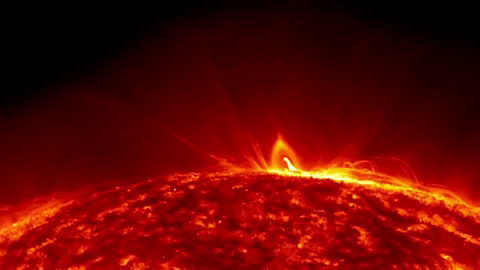Rain comes in various forms throughout the solar system water on Earth, methane/ethane on Titan and sulfuric acid on Venus. But did you know it also rains on the sun? Huge drops of plasma in the sun’s outer atmosphere, the corona, onto the scorching surface.
Mason, a graduate student at The Catholic University of America, was searching for coronal rain: giant globs of plasma, or electrified gas, that drip from the Sun’s outer atmosphere back to its surface. But she expected to find it in helmet streamers, the million-mile tall magnetic loops — named for their resemblance to a knight’s pointy helmet — that can be seen protruding from the Sun during a solar eclipse. Computer simulations predicted the coronal rain could be found there. Observations of the solar wind, the gas escaping from the Sun and out into space, hinted that the rain might be happening.
But she was looking at the wrong place, So where was it? Instead of the helmet streamers, the rain was found in a smaller kind of magnetic loop on the sun. It was there, just not in the place that the researchers had expected to find it.
This research might help scientists to answer two mysteries why the sun’s outer atmosphere is so much hotter than the star’s surface and the source of the slow solar wind. The new data, collected using high-resolution telescopes mounted on NASA’s Solar Dynamics Observatory, showed that coronal rain works similarly to rain on Earth — with a few exceptions.
On Earth, rain is just one part of the larger water cycle, an endless tug-of-war between the push of heat and pull of gravity. In Earth’s hydrological cycle, water evaporates on the surface and rises up into the atmosphere. It then cools and condenses into clouds, and when there is enough moisture in the clouds, it falls back to the surface as rain. Coronal rain is a somewhat similar process, but with a completely different composition of the rain itself.
On the Sun coronal rain works similarly, but instead of 60-degree water you are dealing with a million-degree plasma. Plasma, an electrically-charged gas, doesn’t pool-like water, but instead traces the magnetic loops that emerge from the Sun’s surface like a rollercoaster on tracks. At the loop’s foot points, where it attaches to the Sun’s surface, the plasma is superheated from a few thousand to over 1.8 million degrees Fahrenheit. It then expands up the loop and gathers at its peak, far from the heat source. As the plasma cools, it condenses and gravity lures it down the loop’s legs as coronal rain.
In previous theories, it was thought that coronal rain only occurred in closed loops, where the plasma heats and cools, but can’t escape into space. Mason’s work suggests, however, that the rain begins in a closed-loop, but then switches – through a process called magnetic reconnection – to an open one, like a train switching tracks. Some of the plasma will then escape, but some will fall back to the surface as rain. The plasma that does escape forms part of the slow solar wind.
How and why the Sun’s outer atmosphere is some 300 times hotter than its surface might have a strange connection to the plasma rain. Simulations have shown that coronal rain only forms when the heat is applied to the very bottom of the loop. On the face of it, that observed fact doesn’t seem to make logical sense. As Mason found, the rain in the loops can provide a cutoff point to determine just where the corona is getting heated: If a loop has coronal rain on it, that means that the bottom 10% of it or less, is where coronal heating is happening.
Bottom line is Rain on the sun may sound nonsensical, but it is real and may help to solve some long-lingering puzzles about how our sun works. The researchers plan to study the smaller magnetic loop structures further using NASA’s Parker Solar Probe, which launched in 2018 and has already travelled closer to the sun than any other spacecraft.
